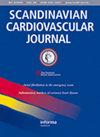Less invasive aortic valve replacement using the trifecta bioprosthesis
IF 1.2
4区 医学
Q3 CARDIAC & CARDIOVASCULAR SYSTEMS
引用次数: 1
Abstract
Abstract Objectives. The safety and effectiveness of the Trifecta GT bioprosthesis (introduced in 2016) in less invasive aortic valve replacement are scarcely investigated. Our aim was to evaluate the immediate and initial follow-up results of this device in the context of less invasive surgery. We discuss patient-specific strategies for the selection of the surgical approach. Methods. A retrospective review of 133 patients undergoing AVR with the Trifecta GT through three less invasive accesses (UMS, Upper ministernotomy; RMS, Reversed ministernotomy; RAMT, Right anterior minithoracotomy) was performed. In-hospital, follow-up and hemodynamic performance (PPM, Patient-prosthesis mismatch) data were collected. Results. Among patients, 79% received UMS, 11% RMS and 10% RAMT. Selection of approach was based on preoperative anatomical analysis (CT-scan) and planned concomitant procedures. There was no operative mortality, no valve-related adverse events. There were 36 concomitant procedures. No significant intergroup differences occurred in cardiopulmonary bypass, aortic clamp, mechanical ventilation time, ICU stay and average bleeding. There were two cases of moderate PPM (1.5%) and no instances of severe PPM; there were no significant (≥2/4) perivalvular leaks. Average mean gradient at discharge was 8 ± 3 mmHg. At follow-up (average: 2.5 ± 0.9 years, 100% complete, 315 patient years) there was no mortality and no valve-related adverse event. Hemodynamic performance was maintained at follow-up. Conclusions. The optimal device for less invasive AVR needs to be individualized, as well as the selection of the surgical approach. The use of the Trifecta GT bioprosthesis appears to be reproductible whatever less invasive approach is employed, with confirmed excellent hemodynamic performance.使用三瓣生物假体的微创主动脉瓣置换术
抽象目标。Trifecta GT生物瓣膜(2016年推出)在微创主动脉瓣置换术中的安全性和有效性几乎没有研究。我们的目的是在微创手术的背景下评估该设备的即时和初步随访结果。我们讨论了选择手术入路的针对患者的策略。方法。对133名使用Trifecta GT通过三种微创途径(UMS,上小切口;RMS,反向小切口;RAMT,右前小切口)接受AVR的患者进行了回顾性审查。在医院,收集随访和血液动力学表现(PPM,患者假体不匹配)数据。后果在患者中,79%接受UMS,11%接受RMS,10%接受RAMT。入路的选择基于术前解剖分析(CT扫描)和计划的伴随手术。无手术死亡,无瓣膜相关不良事件。共有36例伴随手术。体外循环、主动脉夹、机械通气时间、ICU住院时间和平均出血量在组间无显著差异。有两例中度PPM(1.5%),没有严重PPM;无明显(≥2/4)瓣周渗漏。出院时的平均梯度为8 ± 3. mmHg。随访时(平均:2.5 ± 0.9 年,100%完成,315患者年),没有死亡,也没有瓣膜相关的不良事件。随访时维持血液动力学表现。结论。微创AVR的最佳装置需要个性化,以及手术方法的选择。Trifecta GT生物瓣膜的使用似乎是可复制的,无论采用何种微创方法,都具有良好的血液动力学性能。
本文章由计算机程序翻译,如有差异,请以英文原文为准。
求助全文
约1分钟内获得全文
求助全文
来源期刊

Scandinavian Cardiovascular Journal
医学-心血管系统
CiteScore
3.40
自引率
0.00%
发文量
56
审稿时长
6-12 weeks
期刊介绍:
The principal aim of Scandinavian Cardiovascular Journal is to promote cardiovascular research that crosses the borders between disciplines. The journal is a forum for the entire field of cardiovascular research, basic and clinical including:
• Cardiology - Interventional and non-invasive
• Cardiovascular epidemiology
• Cardiovascular anaesthesia and intensive care
• Cardiovascular surgery
• Cardiovascular radiology
• Clinical physiology
• Transplantation of thoracic organs
 求助内容:
求助内容: 应助结果提醒方式:
应助结果提醒方式:


